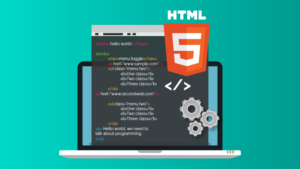Full Stack Development Internship Program
- 29k Enrolled Learners
- Weekend/Weekday
- Live Class
This comparison on HTML vs HTML5 is intended to provide a crisp knowledge about both the markup languages and guide you to find the suitable one if you are building your own web page or web development. This HTML vs HTML5 blog will provide you with a complete insight into the language in the following sequence:
The history of the hypertext markup language is a strange and interesting tale. The man behind HTML, Tim Berners-Lee was putting together his first elementary browsing and authoring system for the Web and created a quick little hypertext language that would serve his purposes.
But the problem lied in the simplicity of the language. HTML was text-based and anyone could use any editor or word processor to create or convert documents for the Web. The developers started implementing new features in their browsers and started releasing advanced versions of HTML.

HTML stands for Hyper Text Markup Language and it is the standard markup language for creating web pages and web applications. It is used to describe the structure of Web pages using markup.

HTML5 is the 5th version of HTML and is a core technology markup language of internet that is used for structuring and presenting the content for www.
Now lets have a look at all the new elements that were added in HTML5 and the factors that make it better than HTML.
Let’s look at the factors we will be using for the comparison on HTML vs HTML5:

The first factor in HTML vs HTML5 is the introduction of audio and video in HTML5. There was no such concept of media in case of HTML. But it is one of the integral part of the 5th Version.




While HTML5 does have risks like constant updates, it is generally easy to keep up with the changes and updates because of the simpler syntax as compared to other versions of HTML. For instance, you have a very simple declaration at the start of the page to set it as an HTML5 page, ie, the doctype declaration.
The comparison on HTML vs HTML5 also includes new elements and tags that have been added to the latest version. HTML5 comes with a number of new elements and eliminates several others. Some of the tags were discarded in the new HTML version and the usage of tags were changed accordingly.
Let’s have a look at some of the important tags that were added in HTML5:
The audio tag and the video tag are the two major additions to the HTML5. The audio tag and the video tag enables developers to embed music and audio on their website.The audio & video tags also have a number of attributes for additional controls.
<audio autoplay=”autoplay” controls=”controls”>
<source src=”music.ogg” />
<source src=”music.mp3″ />
</audio>
There are a few other multimedia attributes and elements that come with HTML5, like the track element that provides text tracks for the video element.
One of the key added elements in HTML5 is <canvas> which has hugely impacted the use of Adobe Flash in websites. The <canvas> element can be used to draw graphics with various shapes and colors via scripting, usually JavaScript. The element is simply a container for the graphics.
<canvas id=”myCanvas” width=”200″ height=”100″ style=”border:1px solid #000000;”>
</canvas>
Another big addition that HTML5 comes with are the new <header> and <footer> elements, indicating a new web anatomy. With these new tags, there is no longer a need to identify the two elements with a <div> tag.
<header><h1>Title </h1><div class=”post-meta”><p>By Author</a> <span class=”category”>Filed in Web 2.0</span></p> </div></header><article><p>Body of text</p></article>
The footer is placed at the bottom of the web page but it can also be placed at the end of a page section.
<header><h1>Title </h1><div class=”post-meta”><p>By Author</a> <span class=”category”>Filed in Web 2.0</span></p> </div></header><article><p>Body of text</p></article>
Given the fact that the web has changed into more just linked paged and documents, the <menu> tag is a welcome addition for greater web interactivity. It represents menu commands for simplicity in desktop and mobile applications.
<body contextmenu=”new-context-menu”>
<menu id=”new-context-menu” type=”context”>
<menuitem>Hello World</menuitem>
</menu>
</body>
Now with this, we come to an end of this comparison on HTML vs HTML5. I Hope you guys enjoyed this article and understood the difference between the two versions and how HTML5 is better and simpler in use. So, if you have read this, you might have a clear idea about which version of HTML you should opt for, while building your own web page.
Now that you have understood the comparison between HTML & HTML5, check out the Web Development Certification Training by Edureka, a trusted online learning company with a network of more than 250,000 satisfied learners spread across the globe.
Web Development Certification Training will help you Learn how to create impressive websites using HTML5, CSS3, Twitter Bootstrap 3, jQuery and Google APIs and deploy it to Amazon Simple Storage Service(S3).
Got a question for us? Please mention it in the comments section of “HTML vs HTML5” and we will get back to you.
 Thank you for registering Join Edureka Meetup community for 100+ Free Webinars each month JOIN MEETUP GROUP
Thank you for registering Join Edureka Meetup community for 100+ Free Webinars each month JOIN MEETUP GROUPedureka.co